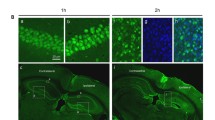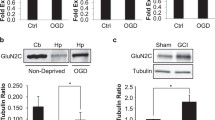Abstract
Ischemic stroke is a dominant health problem with extremely high rates of mortality and disability. The main mechanism of neuronal injury after stroke is excitotoxicity, during which the activation of neuronal nitric oxide synthase (nNOS) exerts a vital role. However, directly blocking N-methyl-d-aspartate receptors or nNOS can lead to severe undesirable effects since they have crucial physiological functions in the central nervous system. Here, we report that nNOS undergoes O-linked-β-N-acetylglucosamine (O-GlcNAc) modification via interacting with O-GlcNAc transferase, and the O-GlcNAcylation of nNOS remarkably increases during glutamate-induced excitotoxicity. In addition, eliminating the O-GlcNAcylation of nNOS protects neurons from apoptosis during glutamate stimulation by decreasing the formation of nNOS–postsynaptic density protein 95 complexes. Taken together, our data suggest a novel function of the O-GlcNAcylation of nNOS in neuronal apoptosis during glutamate excitotoxicity, suggesting a novel therapy strategy for ischemic stroke.






Similar content being viewed by others
Change history
03 May 2017
An erratum to this article has been published.
References
Alderton WK, Cooper CE, Knowles RG (2001) Nitric oxide synthases: structure, function and inhibition. Biochem J 357:593–615
Cao J, Viholainen JI, Dart C, Warwick HK, Leyland ML, Courtney MJ (2005) The PSD95–nNOS interface: a target for inhibition of excitotoxic p38 stress-activated protein kinase activation and cell death. J Cell Biol 168:117–126
Chakroborty S, Kim J, Schneider C, West AR, Stutzmann GE (2015) Nitric oxide signaling is recruited as a compensatory mechanism for sustaining synaptic plasticity in Alzheimer’s disease mice. J Neurosci Off J Soc Neurosci 35:6893–6902
Christopherson KS, Hillier BJ, Lim WA, Bredt DS (1999) PSD-95 assembles a ternary complex with the N-methyl-d-aspartic acid receptor and a bivalent neuronal NO synthase PDZ domain. J Biol Chem 274:27467–27473
Comer FI, Hart GW (2000) O-glycosylation of nuclear and cytosolic proteins. Dynamic interplay between O-GlcNAc and O-phosphate. J Biol Chem 275:29179–29182
Feigin VL, Lawes CM, Bennett DA, Barker-Collo SL, Parag V (2009) Worldwide stroke incidence and early case fatality reported in 56 population-based studies: a systematic review. Lancet Neurol 8:355–369
Fisher M, Feuerstein G, Howells DW, Hurn PD, Kent TA, Savitz SI, Lo EH, Group S (2009) Update of the stroke therapy academic industry roundtable preclinical recommendations. Stroke J Cereb Circ 40:2244–2250
Gambrill AC, Barria A (2011) NMDA receptor subunit composition controls synaptogenesis and synapse stabilization. Proc Natl Acad Sci USA 108:5855–5860
Gatto EM, Riobo NA, Carreras MC, Chernavsky A, Rubio A, Satz ML, Poderoso JJ (2000) Overexpression of neutrophil neuronal nitric oxide synthase in Parkinson’s disease. Nitric Oxide Biol Chem Off J Nitric Oxide Soc 4:534–539
Greengard P (2001) The neurobiology of slow synaptic transmission. Science 294:1024–1030
Gupta SP, Kamal R, Mishra SK, Singh MK, Shukla R, Singh MP (2016) Association of polymorphism of neuronal nitric oxide synthase gene with risk to Parkinson’s disease. Mol Neurobiol 53:3309–3314
Han L, Zhang D, Tao T, Sun X, Liu X, Zhu G, Xu Z, Zhu L, Zhang Y, Liu W, Ke K, Shen A (2015) The role of N-glycan modification of TNFR1 in inflammatory microglia activation. Glycoconj J 32:685–693
Hart GW, Slawson C, Ramirez-Correa G, Lagerlof O (2011) Cross talk between O-GlcNAcylation and phosphorylation: roles in signaling, transcription, and chronic disease. Annu Rev Biochem 80:825–858
Kreppel LK, Blomberg MA, Hart GW (1997) Dynamic glycosylation of nuclear and cytosolic proteins. Cloning and characterization of a unique O-GlcNAc transferase with multiple tetratricopeptide repeats. J Biol Chem 272:9308–9315
Kritis AA, Stamoula EG, Paniskaki KA, Vavilis TD (2015) Researching glutamate-induced cytotoxicity in different cell lines: a comparative/collective analysis/study. Front Cell Neurosci 9:91
Lai TW, Shyu WC, Wang YT (2011) Stroke intervention pathways: NMDA receptors and beyond. Trends Mol Med 17:266–275
Lai TW, Zhang S, Wang YT (2014) Excitotoxicity and stroke: identifying novel targets for neuroprotection. Prog Neurobiol 115:157–188
Li LL, Ginet V, Liu X, Vergun O, Tuittila M, Mathieu M, Bonny C, Puyal J, Truttmann AC, Courtney MJ (2013) The nNOS-p38MAPK pathway is mediated by NOS1AP during neuronal death. J Neurosci Off J Soc Neurosci 33:8185–8201
Lim S, Haque MM, Nam G, Ryoo N, Rhim H, Kim YK (2015) Monitoring of intracellular tau aggregation regulated by OGA/OGT inhibitors. Int J Mol Sci 16:20212–20224
Liu K, Paterson AJ, Zhang F, McAndrew J, Fukuchi K, Wyss JM, Peng L, Hu Y, Kudlow JE (2004) Accumulation of protein O-GlcNAc modification inhibits proteasomes in the brain and coincides with neuronal apoptosis in brain areas with high O-GlcNAc metabolism. J Neurochem 89:1044–1055
Liu J, Pang Y, Chang T, Bounelis P, Chatham JC, Marchase RB (2006) Increased hexosamine biosynthesis and protein O-GlcNAc levels associated with myocardial protection against calcium paradox and ischemia. J Mol Cell Cardiol 40:303–312
Liu X, Ye R, Yan T, Yu SP, Wei L, Xu G, Fan X, Jiang Y, Stetler RA, Liu G, Chen J (2014) Cell based therapies for ischemic stroke: from basic science to bedside. Prog Neurobiol 115:92–115
Longa EZ, Weinstein PR, Carlson S, Cummins R (1989) Reversible middle cerebral artery occlusion without craniectomy in rats. Stroke J Cereb Circ 20:84–91
Luo CX, Zhu XJ, Zhou QG, Wang B, Wang W, Cai HH, Sun YJ, Hu M, Jiang J, Hua Y, Han X, Zhu DY (2007) Reduced neuronal nitric oxide synthase is involved in ischemia-induced hippocampal neurogenesis by up-regulating inducible nitric oxide synthase expression. J Neurochem 103:1872–1882
Mao X, Zhang D, Tao T, Liu X, Sun X, Wang Y, Shen A (2015) O-GlcNAc glycosylation of p27(kip1) promotes astrocyte migration and functional recovery after spinal cord contusion. Exp Cell Res 339:197–205
Platel JC, Dave KA, Gordon V, Lacar B, Rubio ME, Bordey A (2010) NMDA receptors activated by subventricular zone astrocytic glutamate are critical for neuroblast survival prior to entering a synaptic network. Neuron 65:859–872
Rajamani U, Essop MF (2010) Hyperglycemia-mediated activation of the hexosamine biosynthetic pathway results in myocardial apoptosis. Am J Physiol Cell Physiol 299:C139–C147
Rexach JE, Clark PM, Mason DE, Neve RL, Peters EC, Hsieh-Wilson LC (2012) Dynamic O-GlcNAc modification regulates CREB-mediated gene expression and memory formation. Nat Chem Biol 8:253–261
Ryu IH, Lee KY, Do SI (2016) Abeta-affected pathogenic induction of S-nitrosylation of OGT and identification of Cys-NO linkage triplet. Biochim Biophys Acta 1864:609–621
Sattler R, Xiong Z, Lu WY, Hafner M, MacDonald JF, Tymianski M (1999) Specific coupling of NMDA receptor activation to nitric oxide neurotoxicity by PSD-95 protein. Science 284:1845–1848
Shi J, Gu JH, Dai CL, Gu J, Jin X, Sun J, Iqbal K, Liu F, Gong CX (2015) O-GlcNAcylation regulates ischemia-induced neuronal apoptosis through AKT signaling. Sci Rep 5:14500
Shin SH, Love DC, Hanover JA (2011) Elevated O-GlcNAc-dependent signaling through inducible mOGT expression selectively triggers apoptosis. Amino Acids 40:885–893
Soderholm M, Inghammar M, Hedblad B, Egesten A, Engstrom G (2016) Incidence of stroke and stroke subtypes in chronic obstructive pulmonary disease. Eur J Epidemiol 31:159–168
Tallent MK, Varghis N, Skorobogatko Y, Hernandez-Cuebas L, Whelan K, Vocadlo DJ, Vosseller K (2009) In vivo modulation of O-GlcNAc levels regulates hippocampal synaptic plasticity through interplay with phosphorylation. J Biol Chem 284:174–181
Tashiro A, Sandler VM, Toni N, Zhao C, Gage FH (2006) NMDA-receptor-mediated, cell-specific integration of new neurons in adult dentate gyrus. Nature 442:929–933
Tojima T, Itofusa R, Kamiguchi H (2009) The nitric oxide-cGMP pathway controls the directional polarity of growth cone guidance via modulating cytosolic Ca2+ signals. J Neurosci Off J Soc Neurosci 29:7886–7897
Wang J, Chen R, Liu X, Shen J, Yan Y, Gao Y, Tao T, Shi J (2017) Hck promotes neuronal apoptosis following intracerebral hemorrhage. Cell Mol Neurobiol 37:251–261
Yang WH, Kim JE, Nam HW, Ju JW, Kim HS, Kim YS, Cho JW (2006) Modification of p53 with O-linked N-acetylglucosamine regulates p53 activity and stability. Nat Cell Biol 8:1074–1083
Yang WH, Park SY, Nam HW, do Kim H, Kang JG, Kang ES, Kim YS, Lee HC, Kim KS, Cho JW (2008) NFkappaB activation is associated with its O-GlcNAcylation state under hyperglycemic conditions. Proc Natl Acad Sci USA 105:17345–17350
Zachara NE, O’Donnell N, Cheung WD, Mercer JJ, Marth JD, Hart GW (2004) Dynamic O-GlcNAc modification of nucleocytoplasmic proteins in response to stress. A survival response of mammalian cells. J Biol Chem 279:30133–30142
Zeidan Q, Hart GW (2010) The intersections between O-GlcNAcylation and phosphorylation: implications for multiple signaling pathways. J Cell Sci 123:13–22
Zhang X, Ma L, Qi J, Shan H, Yu W, Gu Y (2015) MAPK/ERK signaling pathway-induced hyper-O-GlcNAcylation enhances cancer malignancy. Mol Cell Biochem 410:101–110
Zhang D, Wang H, Liu H, Tao T, Wang N, Shen A (2016) NOS translocates into the nucleus and interacts with Sox2 to protect neurons against early excitotoxicity via promotion of Shh transcription. Mol Neurobiol 53:6444–6458
Zheng S, Eacker SM, Hong SJ, Gronostajski RM, Dawson TM, Dawson VL (2010) NMDA-induced neuronal survival is mediated through nuclear factor I-A in mice. J Clin Investig 120:2446–2456
Zhou L, Zhu DY (2009) Neuronal nitric oxide synthase: structure, subcellular localization, regulation, and clinical implications. Nitric Oxide Biol Chem Off J Nitric Oxide Soc 20:223–230
Zhou L, Li F, Xu HB, Luo CX, Wu HY, Zhu MM, Lu W, Ji X, Zhou QG, Zhu DY (2010) Treatment of cerebral ischemia by disrupting ischemia-induced interaction of nNOS with PSD-95. Nat Med 16:1439–1443
Zhu L, Tao T, Zhang D, Liu X, Ke K, Shen A (2015) NOS1AP O-GlcNAc modification involved in neuron apoptosis induced by excitotoxicity. Int J Mol Sci 16:16560–16575
Acknowledgements
This work was partly supported by the National Natural Science Foundation of China (Nos. 81401013, 81401365, 31270802, 81202368, 81371335), Nantong Science and Technology Project (MS12015056), and a Project funded by the Priority Academic Program Development of Jiangsu Higher Education Institutions (PAPD).
Author’s Contribution
T. Tao predicted the O-GlcNAcylation site of nNOS and performed the mass spectrometry studies. P. Gong, Y. Yan, J. Shen, and C. Duan performed the experiments and the statistical analysis. J. Wang and R. Chen designed the experimental plans. Y. Gao and X. Liu wrote the manuscript.
Author information
Authors and Affiliations
Corresponding authors
Ethics declarations
Conflict of interest
The authors declare no conflict of interest.
Additional information
Rongrong Chen, Peipei Gong, Jun Wang, and Xiaojuan Liu contributed equally to this work.
An erratum to this article is available at https://doi.org/10.1007/s10571-017-0495-z.
Electronic supplementary material
Below is the link to the electronic supplementary material.
Supplementary Fig. 1
Neurological defect scores were assigned based on the Bederson’s scores andmeasured as follows: no deficits score, 0; unable to extend the contralateral forelimb score, 1; flexion of contralateral fore limb score, 2; mild circling to the contralateral side score, 3; severe circling and allying to the contralateral side score, 4. n = 3, p < 0.05 (TIF 39864 kb)
Supplementary Fig. 2
YinOYang 1.2 was used to predict the O-GlcNAc sites of nNOS (rat). The Gene ID of rat nNOS is 24598 (JPG 60 kb)
Rights and permissions
About this article
Cite this article
Chen, R., Gong, P., Tao, T. et al. O-GlcNAc Glycosylation of nNOS Promotes Neuronal Apoptosis Following Glutamate Excitotoxicity. Cell Mol Neurobiol 37, 1465–1475 (2017). https://doi.org/10.1007/s10571-017-0477-1
Received:
Accepted:
Published:
Issue Date:
DOI: https://doi.org/10.1007/s10571-017-0477-1




